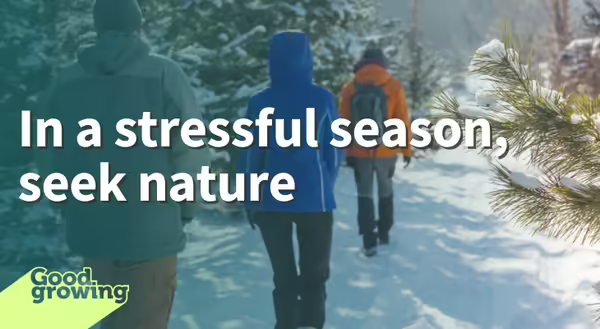
According to songwriters and composers Edward Pola and George Wyle, this is the most wonderful time of the year, but research indicates it may be that and more. According to the American Psychological Association, two in five adults experience an increase in stress levels between November and January. A nearly equal number of adults say that the increased stress affects their ability to enjoy holiday celebrations and gatherings.
As the hustle and bustle of the season continue, the calming, restorative benefits of nature may be just the thing we all need. A growing body of research continues to expand our understanding of the positive health benefits time in nature provides.
Time in nature offers social, emotional, physical, and cognitive benefits regardless of the season. Engaging with natural spaces has been shown to reduce stress levels, thereby leading to a lower risk of chronic disease. Time outdoors exposes us to sunlight contributing to the body’s production of vitamin D, a nutrient that studies indicate contributes to improved bone health and immune system function, lifts mood, and defends against heart conditions and stroke. Symptoms of anxiety and depression are reduced through time in nature while creativity, concentration, and problem-solving skills are enhanced.
Frequent expeditions to the outdoors are prime opportunities to spend time with loved ones. Large group outings or intimate walks with a person both provide a time to connect and strengthen relationships. Being a part of a community, large or small, has been shown to improve well-being and reduce symptoms of depression and anxiety. Combining time in nature with family or friends compounds the beneficial impact of the outdoors.
There are hundreds of ways to increase our time outdoors. Some require special equipment, some involve extravagant travel plans, but not all. Here are a few low-cost, easy-to-implement ways to get outside this winter. Use these as a starting spot then let your imagination run wild. Feel free to email the Good Growing team with your ideas and photos, we love hearing from you.
Schedule walks
People are creatures of habit; in fact, some studies indicate that up to half of our daily activities are done as routine. Developing a habit begins as an intentional, frequently performed behavior. If making time outdoors is a habit you want to develop, start by scheduling time on your calendar. For added motivation, make a note on your calendar as to why you are committed to spending time outdoors, and remind yourself of one or more of the benefits you want to experience through this nature connection. For an added social benefit and accountability, invite a friend to join.
Decorate a natural holiday tree
Birding is a popular nature-based activity any time of year, but the charming little critters are especially delightful in midwinter months. Hanging a birdfeeder outside a window is an easy way to attract and enjoy winter birding. Extend the activity and nature connection by creating natural birdfeeders. Halved citrus fruit, pinecones covered with peanut butter and seeds, or strings of dried fruit and popcorn are a few ways to feed the birds but there are many ways to get creative while getting outside.
Sip a hot beverage in the dormant garden
Many growers happily spend countless hours working and playing in backyard landscapes from spring to autumn, but as flowers fade and leaves fall, dormancy in the garden often results in a hiatus from the garden for the gardeners. During these winter months, the bones and structure of a garden stand out. Spent seedheads of perennial flowers, wispy clumps of grasses, and bare branches of shrubs and trees create an entirely different kind of beauty. Bringing a warm beverage out into the garden creates an exciting contrast between the temperature of winter and the beverage at hand while also elevating your body temperature by up to 2.6 degrees Fahrenheit.
How much time outside?
I know, it’s cold outside so it can be tempting to forgo outdoor activities for a hibernation-inspired winter survival strategy. Before settling in for a long winter’s nap, consider recent research that suggests even a few minutes spent outdoors offer health benefits. Other studies suggest that a minimum of two hours over a week is what it takes to achieve substantial improvements in health.
As this field of study continues to refine recommendations for how much time is optimal, the positive effects of spending time outdoors is supported by a large body of scientific research. Prioritizing time in nature, especially during seasons of life that are more stressful, is an important part of self-care and overall well-being.
As the calendar advances through the next few months, I hope the hustle and bustle of the season brings you magic and joy. And when it all becomes too much, perhaps these words will be your inspiration to bundle up and head outside to find sanctuary.
Good Growing Fact of the Week: First Day Hikes is a nationwide initiative organized by America’s State Parks to encourage people to begin the new year with a walk outdoors on January 1. Events are organized by local park staff, conservation organizations, and volunteer groups.
Thank you for reading!
Sign up for our emails! Want to get notified when new Good Growing posts are available? SIGN ME UP
Give us feedback! How helpful was this information (click one): Very helpful | Somewhat helpful | Not very helpful
MEET THE AUTHOR
Emily Swihart is a Horticulture Educator with the University of Illinois Extension, serving Henry, Mercer, Rock Island, and Stark counties since 2021. Emily provides horticulture programming with an emphasis on trees, native vegetation, and home landscape design.